Four Top-Six Wingers That Can Help the Canucks Win Now and In the Future
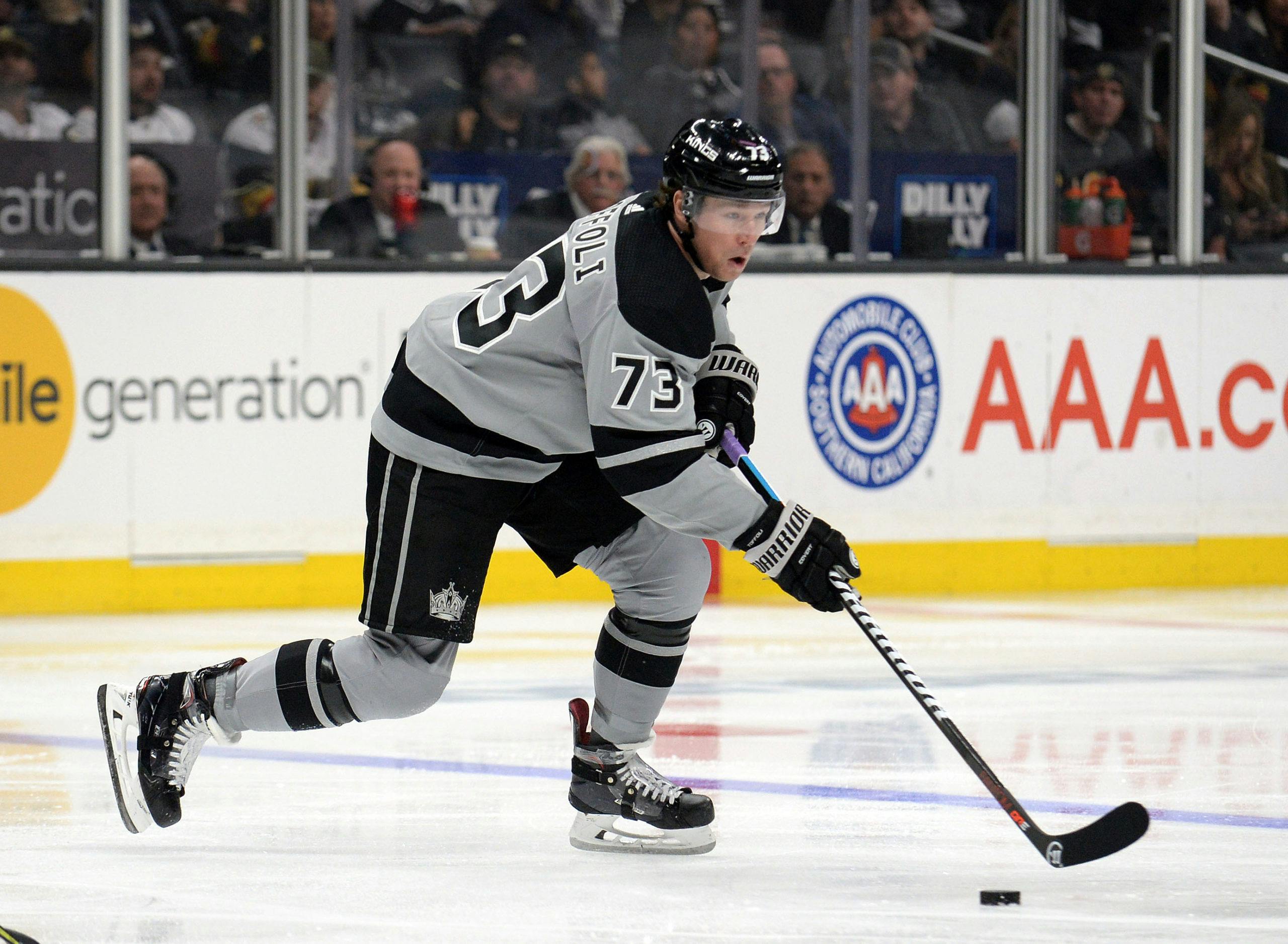
By Brett Lee
4 years agoYesterday, Canucks General Manager Jim Benning spoke to TSN 1040 about a laundry list of topics. Among them was his desire to add a top-six scoring winger in a trade if it “fit and made sense.”
The sentiment is understandable. The line of Brock Boeser, Elias Pettersson, and JT Miller has been exceptional throughout the first two months of the season, ranking fourth in the entire league for expected-goals-for. However, when JT Miller was acquired, he was originally intended to play alongside Bo Horvat. Horvat has had a carousel of wingers over his career as a Canuck and while his current linemates, Tanner Pearson and Josh Leivo, have caught fire as of late, it appears that Benning would like to give his Captain some more firepower on his wing. Currently, the Canucks are extremely reliant on the top half of their lineup to create offence. Vancouver’s four highest-scoring forwards have a combined 117 points. Their next eight have combined for 85. Adding another top-six forward would not only create a trickle-down effect of offence throughout Vancouver’s lineup but it would also give Travis Green more options to work with in the event of an injury.
The Canucks are currently in the upswing of their current core’s life cycle. The team wants to be competitive now while being mindful of what should hopefully be a long window of contention. Any deal made will not only impact them in the present but will have a major influence on their future especially when discussing trades for a bonafide top-six scoring winger. With this in mind, let’s set some filters for the types of winger the Canucks could look to acquire.
First and foremost is age. The Canucks’ best players are also some of their youngest players. Rookie Quinn Hughes just turned 20 and JT Miller is on the other end of the spectrum at 26. The Canucks will likely want a winger that is good enough to handle minutes in the top-six while still having room to grow with this young core. Somewhere between the 22-27 age range is most likely where Benning will look first.
Next, one has to consider what assets will head the other direction. While Vancouver’s prospect pool is among the league’s best, they still are not in the stage of life where they should be selling the farm to acquire talent. This leaves the Canucks looking at young players that are on the verge of breaking out as top-six talents but aren’t quite worth a top-six package in return. Finding a willing suitor to part ways with these players will be difficult as either these are teams that are rebuilding and want to hang on to their young players or are contenders that like the cost-controlled entry-level or second contracts. It’s a fine line to walk as sometimes the player’s potential is worth even more than established top-six players. The Canucks could flip a top prospect, selling high on someone like Tyler Madden, but the return would have to be worth it. The Canucks can also go the rental route but this would move the needle towards the older ages. These would be from rebuilding teams looking to get younger and would make it hard to find a good rental that is still relatively young. However, these players’ skills would already be refined.
The last parameter is contractual. If the Canucks are going to give up significant assets, the team would want to know that the players they are acquiring are either cost-controlled or willing to re-sign to reasonable deals. This makes the rental route risky, as the Canucks could be persuaded into paying their acquisition a sum of money that will cause problems down the line. Going after a young player who still has restricted-free-agent years left makes a lot of sense as the Canucks can control their rights and hold some negotiating power rather than having to convince a free agent. Of course, there’s always a chance that the player thinks he’s worth more than what the Canucks are willing to pay and they go the arbitration route but that still guarantees at least one more season.
Anthony Duclair
As I searched for players around the league that fit the mold, I realized how difficult it is to find a transaction that made sense for both parties. The Ottawa Senators are in the midst of a rebuild and will be looking for future assets. They have Jean-Gabriel Pageau who will most likely be one of the bigger trade baits going into the trade deadline. However, I don’t think his current shooting percentage of 21.3 is sustainable, given that it’s more than double his career percentage of 10.5%. He’s also 27 which places him towards the end of the age window that was discussed. If the Canucks are going to be sacrificing future assets, a younger player with room to grow would be preferable.
The Canucks acquiring Anthony Duclair is a pipe-dream at this point but he’s worth mentioning because if he is somehow available, it would behoove the organization to take a long look at him. At 24, Duclair looks to be coming into his own and displaying the talent that made him one of the top prospects in the QMJHL. Recall that after a trade from the New York Rangers organization to the Arizona Coyotes, he broke out for 44 points in 81 games riding shotgun with Max Domi. He has since never hit the 20 point mark until this season. He has 15 goals and 7 assists in 32 games which extrapolated over an 82 game season would equate to 38 goals and 18 assists. It’s not as if he is riding high percentages either. He has 101 shots in 32 games or just over 3 shots per game and is converting at 14.8%. That’s a healthy volume and a respectable percentage. Looking at his RAPM chart from evolving-hockey.com we can see that he creates quality scoring chances at an extremely good rate. One could also expect his actual goals-for could rise closer to his expected-goals.

Defensively, Duclair is second-worst on the Senators in preventing expected-goals which is a potential cause of concern for Vancouver especially if the idea would be to match him with Horvat who is also tasked matching up against top competition. It is a tale of two stories for Duclair which is reinforced when we look at these heatmaps for 5v5 unblocked shot rates. With Duclair on the ice, the Senators are playing fun hockey if nothing else. The Senators are creating an exceptional amount of unblocked shots in the most dangerous area of the ice but are also surrendering them at nearly the same rate.
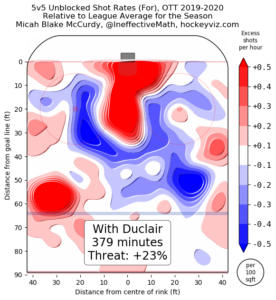
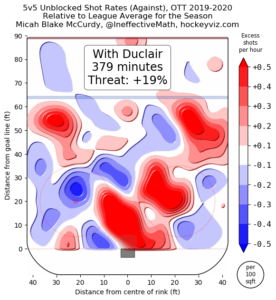
While I doubt the Senators have any intention of moving on from Duclair, his defensive deficiencies could be an area of leverage for interested teams. Duclair is also due for a hefty contract extension, which means the notoriously stingy Sens could be willing to part with him under the right circumstances. The asking price may also be too rich for the Canucks so a deal between the two parties makes little sense. Count this as the most unrealistic and wishful thinking of the proposed players.
Josh Anderson
Had anyone asked Jarmo Kekäläinen about the 25-year-old power forward the last off-season, they likely would have heard the dial tone. He just came off a breakout 27 goal, 20 assist season for the Blue Jackets and was looking like one of the game’s premier power wingers. While impressions of Anderson should not have changed between last April and now, one has to wonder if Anderson’s slump has made him movable from the Jackets’ perspective.
Josh Anderson is the ideal power forward for today’s game. He has a forceful stride with good mechanics that make him incredibly difficult to stop once he gets going as well as strong footwork that allows him to accelerate using crossovers. Away from the puck, he can gather speed to give him the advantage once he has the puck and can use his imposing size and shot to impact the game. He’s also a very smart player that can be trusted to close out games with the net empty.
The goal he scored against Vancouver perfectly encapsulates both his offensive prowess and responsible defensive game. Columbus is transitioning in its own zone and Anderson is curling back to support the lone defenceman. Adam McQuaid’s outlet pass gets deflected by Tanner Pearson and it looks like Bo Horvat has a chance to intercept the puck. Anderson could have blown the zone early, anticipating a quick transition into the neutral zone but instead he is patient and makes sure that the puck gets past Horvat before beginning his cross-over acceleration. Pierre-Luc Dubois does good work along the boards to free the puck and Anderson pounces using his built up speed and space. It’s clear that when he sees this opportunity coming, his actions are instinctual. He shifts into another gear and once he has the puck, nothing is stopping him from taking the puck to the net.
After watching a play like this, it’s easy to imagine him bursting down the ice on Horvat’s wing. The two were also teammates for the London Knights, which would give the Canucks’ a level of familiarity.
His slump this year shouldn’t deter Columbus from thinking highly of him. According to chartinghockey.ca, Anderson is second last in the league for real goals vs expected goals meaning, the scoring chances have been there, he just hasn’t had the bounces go his way.

He is shooting a measly 1.6%, down from his career average of 10.5% while averaging 2.6 shots-per-game. Last year he averaged 2.8 shots-per-game at an 11.7% conversion. He is also positively impacting the Blue Jackets at both ends of the ice. With Anderson at 5v5, the Blue Jackets are getting an above-average amount of quality chances while negating those same chances against.
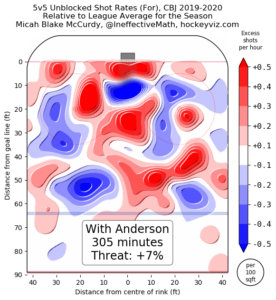
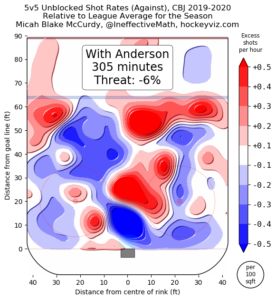
With just 1 goal and 3 assists in 24 games, Josh Anderson is due to regress and is another player the Canucks are unlikely to pry away, but one they should be looking into nonetheless. Anderson isn’t exactly a buy-low candidate unless this slump is due to something other than poor luck, so the asking price would likely be steep. However, he’s young and impactful enough where moving a higher-end prospect could make sense to a certain point-of-view.
Warren Foegele
The Carolina Hurricanes are one of the most exciting teams to follow right now. Not only are they one of the best teams in the league that play sustainable hockey but they have fun doing so. Plus they are built with analytical support at their core alongside the traditional building blocks. Andrei Svechnikov, Sebastian Aho, Teuvo Teravainen, and Martin Necas are the young forwards that are getting a lot of attention but Warren Foegele is a player that deserves recognition too. Aside from the potential Superbad references – I love a good Superbad reference – Foegele provides solid two-way play in the top-six. Not only is he due for some more points but he is also part of a formidable shut-down line.
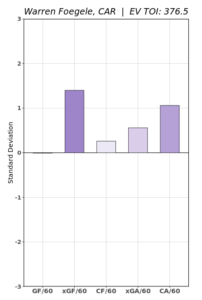
Since being united with Andrei Svechnikov and Jordan Staal, Foegele has been part of one of the stingiest lines in hockey by expected-goals-against. They rank third in this regard for lines that have played at least 50 minutes of 5v5 action together according to moneypuck.com.

While he isn’t a goal scorer like the first two players mentioned, he is an efficient point-producer, ranking 6th on the Hurricanes in both primary assists-per-60 and points-per-60. From a statistical standpoint, it looks as if he is a true top-six player at 23. The main value he brings would be his two-way play and his willingness to do the things others are not which is an essential component in the top-six. He’s fast, strong along the boards, and has a good net-front presence with his size and hand-eye ability. He is a player that can play anywhere in the lineup and provide a little bit of everything with room to grow.
Again, this is most likely an unrealistic proposal as the Hurricanes are looking to contend for a Stanley Cup. Foegele is young and cheap which provides great value and therefore would not make sense to part ways with at this time. It would have to be a large upgrade over Foegele talent-wise for Carolina to even consider and are pieces that the Canucks don’t have to give.
Tyler Toffoli
The most realistic of the players, Tyler Toffoli is stuck on a rebuilding LA Kings team. He turns 28 in April but has a longer track record of scoring than a player like Jean-Gabriel Pageau. His career-year came in 2015-16 when he scored 31 goals and 27 assists in 82 games but has since only reached the 20 goal mark once. This year, he has 7 goals and 8 assists in 31 games but his underlying numbers look promising and there’s reason to believe his counting stats could improve if put into a new environment.
Using tracking data done by Corey Sznajder, Tyler Toffoli ranks second in the entire league in primary-shot-contributions for players with at least 40 minutes of tracked ice-time. Yes, that’s a small sample size, it’s about 3-4 games worth of data but it still paints a picture of the type of player Tyler Toffoli is. Toffoli is a pure shooter that can get shots off in dangerous areas at a high volume. This is a player that I can very easily see Benning looking at.
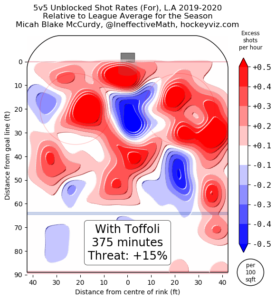
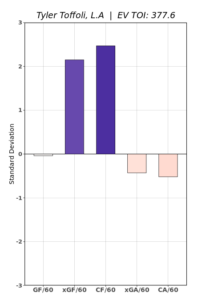
His contract also expires after this year which means if the Canucks want to go after Toffoli, they would most likely engage in contract talks before any trade is solidified.
Honourable Mention
Briefly, I’ll also mention Chris Kreider, the Rangers power-forward here as another rental turned to re-sign option as well. Should the Rangers be looking to move him this deadline, he will most likely be one of the biggest fish and considering he is about to turn 29 and the toll playing his style of game takes on the human body, the Canucks should stay away. Kreider is a win now, forget about the future move.
Conclusion
Three of the four players mentioned are unrealistic targets, but that only serves to underline the issue with the prospect of the team going fishing for a top-six forward in a trade. Given what the Canucks’ ambitions are for the future and the current assets that they have, they aren’t in the position to be looking for expensive rentals like Chris Kreider, nor do they have an excess of prospects to try and pry away a young player from other teams. Ideally, the Canucks are looking for a young winger that can play in the top-six, but so are 30 other teams.
The Tyler Toffoli route is easily the one that is most realistic but then the question becomes: is a couple of good seasons from Toffoli before he turns 30 worth leveraging prospects, picks, and cap space? For the time being, the Canucks need to have patience. More high impact wingers are needed but luckily for them, that is their prospect pool’s biggest strength. Vasili Podkolzin, Nils Hoglander, Kole Lind, and potentially Tyler Madden. should he move to the wing, all have varying degrees of top-six upside. They are far from a sure thing, but from a long-term perspective, it makes sense to do whatever they can to develop these players rather than going out and finding a short-term solution.
If the Canucks are really desperate for a top-six winger, Sven Baertschi is still a guy that I firmly believe can slot into the top-six and not look out of place, and currently has 21 points in 14 games with the Comets. Vancouver, I’d argue, has more pressing issues than wingers currently. The defence still needs help and relying on Alex Edler and Chris Tanev in the future is not a recipe for success. For now, the team would be wise to let the winger issue resolve itself through natural progression unless one of the young forwards mentioned or someone similar becomes a possibility. It is a promising sign that Benning has identified the need to be patient and find the right fit. However, I suspect the right fit may come internally rather than elsewhere.
Recent articles from Brett Lee





